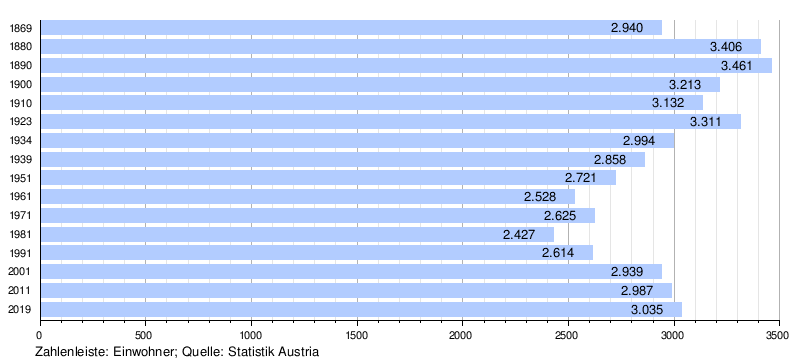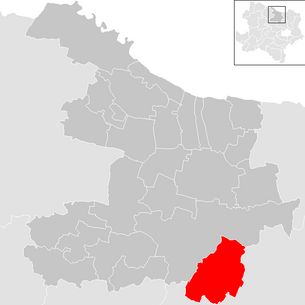Goellersdorf
|
market community Goellersdorf
|
||
|---|---|---|
| coat of arms | Austria map | |
|
|
||
| Basic data | ||
| Country: | Austria | |
| State : | Lower Austria | |
| Political District : | Hollabrunn | |
| License plate : | HL | |
| Surface: | 59.65 km² | |
| Coordinates : | 48 ° 29 ' N , 16 ° 7' E | |
| Height : | 202 m above sea level A. | |
| Residents : | 3,064 (January 1, 2020) | |
| Population density : | 51 inhabitants per km² | |
| Postal code : | 2013 | |
| Area code : | 02954 | |
| Community code : | 3 10 08 | |
| NUTS region | AT125 | |
| Address of the municipal administration: |
Hauptplatz 10 2013 Göllersdorf |
|
| Website: | ||
| politics | ||
| Mayor : | Josef Reinwein ( ÖVP ) | |
|
Municipal Council : ( 2020 ) (21 members) |
||
| Location of Göllersdorf in the Hollabrunn district | ||
| Source: Municipal data from Statistics Austria | ||


Göllersdorf is a market town with 3,064 inhabitants (as of January 1, 2020) in the Hollabrunn district in Lower Austria .
geography
Göllersdorf is located in the Weinviertel in Lower Austria around 15 km north-northwest of Stockerau in the valley of the Göllersbach . The area of the market town covers 59.56 square kilometers. About a third of the area is forested.
Community structure
The municipality includes the following 12 localities (population in brackets as of January 1, 2020):
- Bergau (228)
- Eitzersthal (156)
- Furth (173)
- Göllersdorf (1431) including Viendorf
- Grossstelzendorf (309)
- Obergrub (88)
- Oberparschenbrunn (91)
- Porrau (99)
- Schoenborn (17)
- Underground (95)
- Viendorf (295)
- Wischathal (82)
The community consists of the cadastral communities Bergau, Eitzersthal, Furth, Göllersdorf, Großstelzendorf, Obergrub, Oberparschenbrunn, Porrau, Schönborn, Untergrub, Viendorf, Viendorf Weingebirge and Wischathal. The place Viendorf exists both as a separate village and as a district of Göllersdorf.
Neighboring communities
| Hollabrunn | ||
| Hollabrunn |

|
Großmugl (Korneuburg) |
| Russbach (Korneuburg) | Sierndorf (Korneuburg) |
history
The current municipal area was already settled in the Neolithic . Göllersdorf was first mentioned in a document around 1130. The cadastral community Großstelzendorf was first mentioned in 1195. A market in Göllersdorf is occupied for the year 1468.
The Göllersdorf Castle, a Renaissance building from the 16th century, in which elements from around 1460 have been preserved, and in which the Göllersdorf prison is housed today, has belonged to the von Puchheim family since the 14th century . Göllersdorf becomes historically significant through the contract between Emperor Ferdinand II and Wallenstein (" Agreement of Göllersdorf "), concluded in Göllersdorf Castle on April 14, 1632 at a meeting between Albrecht von Wallenstein and the Imperial First Minister Johann Ulrich von Eggenberg was reinstated as commander in chief of the imperial army.
In 1711 the Electoral Mainz minister Melchior Friedrich Graf von Schönborn-Buchheim acquired the dominions of Göllersdorf, Mühlberg and Aspersdorf from the last Puchheimer, the bishop of Wiener Neustadt, Count Franz Anton Buchheim. Melchior Friedrich's son, the Imperial Vice Chancellor (and later Prince-Bishop) Friedrich Karl von Schönborn-Buchheim , who lived in Vienna , commissioned the architect Johann Lukas von Hildebrandt to convert the Mihlberg Fortress, which was on the property, into a representative country palace (1711–1718), the south from Göllersdorf located Schönborn Palace . It still belongs to the Schönborn family today . The Göllersdorf Castle was sold in the 1970s and is now used as a correctional facility.
Population development
The sharp increase in the number of inhabitants from 1981 to 2001 is based on a strongly positive balance of migration despite a slightly negative birth balance . The birth balance has also been positive since 2001, but immigration has decreased.

politics
The municipal council has 21 members.
- With the municipal council elections in Lower Austria in 1990, the municipal council had the following distribution: 13 ÖVP, 4 SPÖ, 3 citizens' list Hollabrunn, and 1 FPÖ.
- With the municipal council elections in Lower Austria in 1995, the municipal council had the following distribution: 12 ÖVP, 5 SPÖ, 2 FPÖ, and 2 citizens' lists Hollabrunn.
- With the municipal council elections in Lower Austria in 2000, the municipal council had the following distribution: 13 ÖVP, 6 SPÖ, and 2 FPÖ.
- With the municipal council elections in Lower Austria in 2005 , the municipal council had the following distribution: 12 ÖVP, 8 SPÖ, and 1 FPÖ.
- With the municipal elections in Lower Austria in 2010 , the municipal council had the following distribution: 12 ÖVP, 7 SPÖ, and 2 FPÖ.
- With the municipal council elections in Lower Austria in 2015 , the municipal council had the following distribution: 11 ÖVP, 5 SPÖ, 3 Greens, and 2 FPÖ.
- With the municipal council elections in Lower Austria 2020 , the municipal council has the following distribution: 11 ÖVP, 5 SPÖ, 4 citizens list Göllersdorf and 1 FPÖ.
- mayor
- until 2008 Alfred Scheidl (ÖVP)
- since 2008 Josef Reinwein (ÖVP)
Culture and sights
- Göllersdorf Castle: Renaissance castle. This is where the Göllersdorf Prison is now located , where the mentally abnormal lawbreakers of the Austrian penal system are housed.
-
Schönborn Palace : baroque, also a work by Johann Lucas von Hildebrandt. Count Schönborn's hunting lodge in Porrau is ascribed to the same builder.
- in the palace gardens: Schönborn Palace Golf Course
- Catholic parish church Bergau hl. Aegydius: built as a baroque hall at the end of the 17th century; At the beginning of the 18th century the western church tower was given a classical facade. Altarpiece depicting St. Aegydius by Johann Josef Schindler .
- Catholic parish church Göllersdorf hl. Martin: at the southern end of the main square in Göllersdorf. It was built from 1456 and in 1740/1742 by Johann Lucas von Hildebrandt on behalf of Friedrich Karl von Schönborn-Buchheim, rebuilt and expanded in baroque style. The north tower and the choir have been preserved from their Gothic core.
- Catholic parish church Großstelzendorf hl. Andreas: Late Baroque, attributed to Johann Lucas von Hildebrandt. The north tower and choir have been preserved from its Gothic predecessor. There are several altars in the Großstelzendorfer church, one of which was made by Martin Johann Schmidt with the depiction of the three wise men . Numerous late Baroque sandstone tombstones have been preserved in the cemetery around the church.
- Oberparschenbrunn local chapel: the chapel dedicated to St. Laurentius was opened at the turn of the 17th and 18th centuries. It was built in the 18th century and should not be confused with the field chapel north of Oberparschenbrunn, which was only built at the end of the 19th century.
- Loreto Church: built 1725–1730; served as the crypt church of the Counts of Schönborn-Buchheim
- Loreto Chapel: the Loreto Chapel, built between 1694 and 1715, is attached to the Loreto Church
- Castle gate on the main square: It was built by Count Franz Anton von Puchheim in 1703 on the occasion of Charles III's transit . (Counter-King of Spain) erected in Lisbon to ascend the throne.
economy
In 2010 there were 95 agricultural and forestry holdings, of which 63 were full-time farms. In 1999 there were 144 farms with 85 full-time jobs. The manufacturing sector employed 253 workers in 30 factories, around half in the manufacture of goods and half in construction. The service sector employed 379 people in 123 companies. Almost half of them worked in public and social services, around a quarter in trade (as of 2011).
traffic
The market town of Göllersdorf is very well connected by rail and road.
Göllersdorf is about right on the Nordwestbahn with regular express trains . There is a Park & Ride facility near the train station .
Regarding the road connection, the Tullner Straße B19 and the Weinviertel expressway S3 should be mentioned. The federal capital Vienna can be reached quickly via the S3 .
education
There is a kindergarten, an elementary school and a new middle school in the community .
health
General practitioners and specialists are ordained in Göllersdorf.
Personalities
- Sons and daughters of the church
- Wilhelm Scherer (1841–1886), Austrian Germanist, one of the most influential Germanists at the end of the 19th century, half-brother of Anton von Stadler
- Anton von Stadler (1850–1917), Austro-German painter, director of the Munich Art Academy
Web links
- 31008 - Göllersdorf. Community data, Statistics Austria .
Individual evidence
- ↑ Statistics Austria: Population on January 1st, 2020 by locality (area status on January 1st, 2020) , ( CSV )
- ^ Statistics Austria, A look at the community of Göllersdorf, population development. Retrieved October 16, 2019 .
- ^ Result of the local council election 1995 in Göllersdorf. Office of the Lower Austrian State Government, March 30, 2000, accessed on June 20, 2019 .
- ^ Election result of the municipal council election 2000 in Göllersdorf. Office of the Lower Austrian State Government, February 4, 2005, accessed on June 20, 2019 .
- ^ Election result of the municipal council election 2005 in Göllersdorf. Office of the Lower Austrian State Government, March 4, 2005, accessed on June 20, 2019 .
- ^ Election result of the municipal council election 2010 in Göllersdorf. Office of the Lower Austrian State Government, October 8, 2010, accessed on June 20, 2019 .
- ^ Election result of the 2015 municipal council election in Göllersdorf. Office of the Lower Austrian State Government, December 1, 2015, accessed on June 20, 2019 .
- ↑ Results of the municipal council election 2020 in Göllersdorf. Office of the Lower Austrian State Government, January 26, 2020, accessed on March 25, 2020 .
- ^ Statistics Austria, A look at the community of Göllersdorf, agricultural and forestry operations. Retrieved October 16, 2019 .
- ^ Statistics Austria, A look at the community of Göllersdorf, workplaces. Retrieved October 16, 2019 .
- ^ Statistics Austria, A look at the community of Göllersdorf, employees. Retrieved October 16, 2019 .
- ^ P + R Göllersdorf
- ↑ Marktgemeinde Göllersdorf, Our Göllersdorf, School & Education. Retrieved October 16, 2019 .
- ↑ Marktgemeinde Göllersdorf, Unser Göllersdorf, Health & Social. Retrieved October 16, 2019 .












